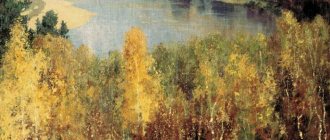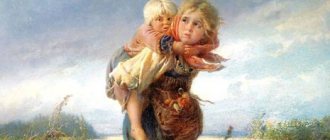Isaac Ilyich Levitan is a talented Russian artist. He is considered the outstanding founder of landscape painting of the 19th century, a spiritual master who creates a poetic image of nature. His paintings are filled with warm, soft tones. Simple images of Russian nature bring peace, tranquility and quiet joy of contemplation. Levitan's paintings are landscapes of mood with surprisingly truthful authenticity. During his creative biography, Levitan created thousands of paintings and sketches.
“Evening Bells” is a landscape by Isaac Levitan, painted in 1892. The painting belongs to the State Tretyakov Gallery.
Let's look at the picture in detail and answer the questions.
Questions about the painting “Evening Bells”
- What is evening bell? Evening ringing is the beginning of the evening service, and the Orthodox daily cycle of worship begins with it.
- What impression did the picture make on you? What did you like?
- What time of year is shown in the picture? What time of day? What does this indicate? Warm summer evening. The sun had already dropped behind the forest, casting its last rays over the horizon and illuminating the monastery and the forest.
- What else did the artist depict? A ferry floats along the river, carrying people to the other side. Monastery surrounded by autumn forest. The temple is located at the bend of a deep, calm river. High pre-sunset sky, clear and brightly reflected in the river. The horizon is closed by an oak forest. People sailing to the temple for evening prayer.
- Describe the monastery. What place does he occupy in the picture? A wide road leads to the monastery; pilgrims walk along it. Gate in the form of an arch. The monastery is illuminated by the last rays of the sun. A bell tower rises above the forest. The artist depicted the monastery in the center of the picture.
- What do you see in the foreground? In the central part? On the background?
- The painting is called “Evening Bells”. Is it possible to depict sound on canvas? Let's get into the picture. What sounds do we hear? The ringing of bells, the music of the wind, the singing of birds, the rustling of leaves, the sound of the river). (It’s a windless evening: the flowers, grass, leaves on the trees are motionless, the clouds are almost motionless, there are light ripples along the river from the ferry. Water is always sounds.
- How does the artist express his attitude towards what he sees? With the help of colors - warm, gentle; shades of green, yellow, brown, pinkish-lilac. The picture is transparent. Paints are not only color, they are the basis for expressing mood, state, feeling. Only in color can you feel how shadows fall on the ground, how transparent and calm the river is.
- Why is the painting called “Evening Bells”? Let's go back to the picture that we will hear: the evening ringing combines the ringing of bells, the sounds of nature, and the magical music of the artist's soul.
- How do you feel when you hear a bell ringing? When the bells ring, a feeling of solemnity, grandeur, and grace arises in the soul.
- What mood does this picture evoke? When I look at the picture, I have a feeling of calm, peace, expectation of something bright, kind, good.
Popular writings
- Essay Love is stronger than death (reasoning)
Love is a wonderful feeling that every person should experience in their life. Writers constantly describe this feeling in their works. Everyone describes a wonderful relationship between two people - Essay by Ivan Timofeevich in the story by Olesya Kuprin (Image and Characteristics)
Ivan Timofeevich is the main character and narrator of the story “Olesya”. This is an intelligent young gentleman of tall stature and thin build. He received a good upbringing and education in the city. - Essay Brudasty in the History of a City (Characteristics and Image)
Dementy Varlamovich Brudasty is the eighth mayor of the city of Foolov. Appointed to the post in August 1762. Busty became famous for putting the arrears in order.
Plan for a descriptive essay based on the painting “Evening Bells” by Levitan
1. Introduction: Before us is a painting by a wonderful artist_____ (indicate the full name of the artist and the name of the painting) During a literary reading lesson, we met the magnificent painting ___________ (indicate the full name of the artist and the name of the painting) The painting (it) was painted in the genre _______( indicate the genre) 2. Main part: In the foreground of the painting: In the foreground of the painting we see_____(what?) The journey into the world of the painting begins with _______(what?) In the foreground of the painting, the artist depicted _____(what?) In the foreground, the artist highlighted_____ (what?) (in some color (specify) and/or composition). Directly in front of us are _____(who/what?) In the center of the picture: In the center of the picture we see _____(who/what?)__________what? In front of us are depicted ______(who/what?)_______________which In the background: In the background of the picture is located (use the desired shape) _______(what?/who?) The background is occupied by_____(what?) In the distance opens_____(what?) Color scheme: Depicting ____(what?) The artist uses a huge range of colors and shades. (Next, describe in detail the color scheme of the painting) The colors in the painting are amazing: ____ (list) ______ (what?) colors predominate in the painting. This makes the picture____(what?) 3. Conclusion What mood, emotions does this picture evoke in you? When I look at the painting ____ (whose? + title), I remember ____ (what?) Admiring the painting, I felt ____ (what?) The painting creates ____ (what?) mood. This canvas smells of _____(what?) The artist managed to brilliantly convey ____mood.
Essay based on the painting “Evening Bells” by Isaac Levitan, grade 3
In front of me is a painting by the great Russian artist Isaac Levitan “Evening Bells”. Warm summer evening. But the sun has not yet hidden. It illuminates the white walls of the church and the autumn forest. In the foreground there is a shore and two boats. Another boat with people swam to the middle of the river. Believers rush to the evening service at the temple. On the other side, monks are waiting for them. There is a wide road from the river to the temple. The blue sky and dark blue river seemed to envelop the white monastery in their tranquility. The clear, calm water reflects curly pinkish clouds and a white temple with golden domes. In the background you can see a church with numerous bell towers. All buildings are surrounded by dark green trees. But yellow bushes are already visible. The sun's rays give the trees an autumn glow. The sound of bells gathers everyone for evening prayer. The painting exudes calm and grandeur.
***
The painting “Evening Bells” was painted by the famous artist I. Levitan in the 19th century. The landscape depicts evening, the sun is already setting behind the horizon. It casts its rays on the forest, temple and river. The dark blue river takes up almost half of the picture. It is quiet and calm, and the entire distant shore is reflected in it, like in a mirror. A boat with people is floating in the middle of the river. In the foreground we see the shore, two boats are rocking at the pier. In one there is a fisherman. The shore is dotted with wildflowers that emerge from the faded autumn grass. On the other bank are the white buildings of the monastery, which are surrounded by mixed forest and bushes. The domes of the temples are cast in gold, playing with the sun's rays. The author used warm colors to paint the picture. Even the blue sky is decorated with pinkish light clouds. The landscape is magnificent! It feels cool and quiet. I want to sit in a boat, listen to the sounds of bells, birdsong, and take a break from the bustle of the world.
Essay 2
Isaac Levitan painted this picture in 1892. He amazingly knew how to give names to his paintings. You read, and it seems that you hear a ringing floating above the surroundings. Landscape of an ordinary Russian area with a church, of which there are many in Rus'. A gently sloping shore with a dilapidated wooden pier, next to two fishing boats. In one of them a man is peacefully dozing. Another boat is visible on the calm water surface. There are people sitting in it. They head to church for the evening service. On the opposite bank there are two monks. Whether they are waiting for people from the boat, or want to cross to the opposite shore - we are not destined to find out. Behind them, a path leads to the gates of a church or monastery. The picture exudes the calm and regularity of provincial Russian life. When there is nowhere and there is no need to rush, neither people nor nature. The river calmly carries its waters and smoothly goes around the island with the monastery. In it, as in a mirror, the golden onions of the domes and white stone walls, as well as the pointed spire of the bell tower, are reflected. And pink clouds float across the evening sky. The rays of the setting sun illuminate the picture. Nature, as an experienced illuminator, allows you to see and feel the main thing in the picture - peace. Dusk falls on the right bank on the left side. In the background of the picture is a monastery surrounded by forest. However, it immediately attracts the viewer's eye. So, it seems that the crimson ringing of bells is floating over the calm waters. And the souls of the spectators, the man in the boat, the monks, and the pilgrims immediately become calmer and happier. The ringing of bells is one of those sounds that is so close to Russian people. In Rus', the bell heralded joy, sadness, and the approach of enemies. The only things that can compete with it are the singing of birds at dawn, the murmur of water in a stream, or a prayer spoken in a low voice to the Almighty. The bells are tuned to certain specific notes, which evoke only positive emotions in the human soul, they even lead to the death of viruses. With the help of bells, people transmitted messages over long distances. After all, the ringing of a bell, especially in frosty air or over water, can be heard far away. The river is like a border separating two worlds. The first one is with a dilapidated pier and a man in an old boat. The second is on the other side, where there are completely different worldviews. And the church and chapel look so solid. And outside the gates, it’s as if a person finds himself in a completely different world.
Essay based on the painting “Evening Bells” by Isaac Levitan, grade 4
***
Landscape artist Isaac Levitan introduces us to his work “Evening Bells”. The journey into the world of this picture begins with a view of the river and sky. Most of the canvas is occupied by a calm river. The weather is calm, and in the still surface of the water you can see the reflection of a snow-white temple with golden domes and an autumn forest. A boat is sailing to the far shore. The people sitting in it are silent, thinking their thoughts. Smoothly floating clouds also froze over the church, listening to the overflow of bells, birdsong and splashes of water from the oars. In the foreground of the painting, the artist depicted the shore. Gray sand and already withered green grass give the picture special meaning. Everyone is waiting for autumn and cold. There are two boats moored near the shore. A man sits in one. Perhaps it's a fisherman. In the center of the picture we see a white monastery and a forest. Depicting nature, I. Levitan used a huge range of colors and shades. From the soft pink sky and the gray-blue river the artist smoothly moves to the image of a golden forest and bright bushes. Green color in several shades is visible along the banks of the river. And only the buildings of the monastery remain light even in the evening, shimmering in the rays of the setting sun. I liked the picture! The artist managed to brilliantly convey the mood of calm, silence, and melody. The sounds of nature and bells are intertwined into one.
Essay based on Levitan’s painting “Evening Bells”
Isaac Levitan... It is unlikely that there are many people in Russia who would not be familiar with this name. Anyone who studied using the Soviet textbooks “Native Speech” and “Literature” will certainly remember his landscapes placed on the covers or endpapers of these books. Numerous reproductions of his works will also appear in their memory, according to which middle school students were taught to write essays on landscapes and still lifes. These paintings are still studied in school today. Almost not a single lesson on Yesenin’s lyrics can be done without relying on Levitan’s masterpieces; his works echo the motifs and mood of the poems of Tyutchev and Fet.
It is not without reason that the artist’s works are so clearly included in the school curriculum. After all, they are tangible: nature, recreated by the Russian author, seems to come to life. Looking at this, it’s as if you feel the breath of a light breeze, hear the rustling of leaves, the sound of the wind or the cry of flying birds, or feel the pleasant smell of freshly cut grass. In Levitan's paintings everything is filled with life.
One of the artist’s most striking and at the same time stunningly attractive paintings is the work “Evening Bells”. It was written by the author in 1892 during walks along the Volga near the Savvino-Storozhevsky Monastery.
Does your teacher check for plagiarism? Order a unique work from us for 250 rubles
Connect with us:
In the foreground, Levitan depicted part of a huge river. One of its banks is sandy and therefore empty. The other shore seems to be opposed to its pair: it is covered with dense, bright vegetation, with many trees rising on it. On the sandy shore closest to the viewer, the author showed two boats, in one of which a peasant was sitting and seemed to be waiting for someone. Another boat is floating on the water, several vacationers are sitting in it. The river is calm and favors skiing on its surface.
The opposite side is shown in the background. It is bathed in the gold of the setting sun. From its center a winding road runs forward, which reaches the gates of the monastery. Two people are seen walking. The church is reflected in the Volga as in a mirror. It seems that she, as if alive, enjoys her beauty, emphasized by the warm sunset. To the left of the monastery there is a green forest. Above all this wealth rises the endless sky. It is calm, like the surface of the reservoir, attracting the eye with its rare blueness. Yellow-pink cirrus clouds slowly float across it.
“Evening Bells” seems to be imbued with peace. Everything presented on it, both created by God and by human hands, seemed to have frozen. Even people walking are in no hurry. It seems that they are walking slowly, talking about something, and every now and then they stop and admire the uniqueness of this evening.
Levitan was able to capture those moments when the church bells recently rang. That’s why everything stands enchanted by a beautiful, sonorous shimmer. Everyone cannot say goodbye to these unique sounds, everyone wants to prolong the pleasure, to allow it to be deposited in the consciousness for a long time. It seems that echoes of the peculiar melody still fly over the wide open spaces.
The picture calms the person looking at it, puts the person in the mood for good, makes him think, remember, and dream. She beckons, you definitely try to return to her. Standing next to her, you ask yourself questions, think and really find answers to everything that has been haunting your soul for so long.






